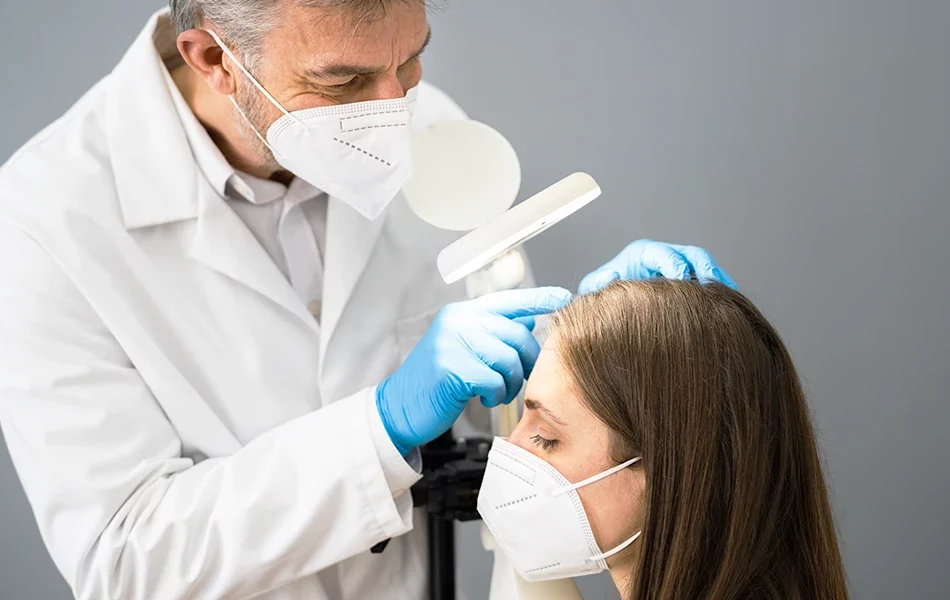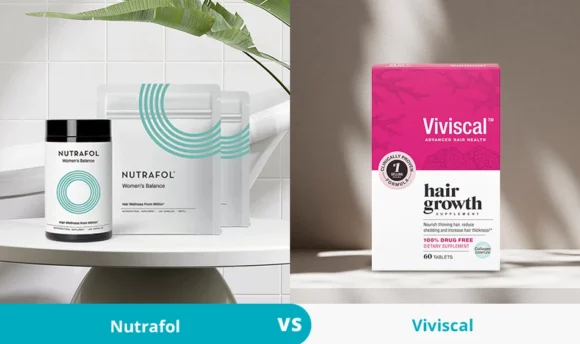Losing Hair After COVID-19: Why It Happens and How to Treat It
Post-COVID-19 patients may experience hair loss, ranging from mild to severe, months after the initial infection. Find out how to recognize it, how long it lasts, and what you can do to help your hair grow back.

It’s alarming but true: severe hair loss can occur after a COVID-19 infection. As with any stressful event, COVID-19 can trigger telogen effluvium, a condition in which your body sheds more hair than normal.
Understanding COVID-19-related hair loss can make it less frightening. It can help you cope better until your hair recovers.
Read on to learn what COVID-19-related telogen effluvium is and how you can help your hair regain its normal fullness.
Losing Hair After COVID-19: Reality Check
Hair loss may occur several weeks or months after the onset of COVID-19 symptoms. But while it can be serious and alarming, you’re not losing hair follicles.
After about 3–6 months of hair loss, your hair will begin to regrow. In rare cases, you may experience chronic hair loss that can last up to several years.
What Causes Hair Loss?
The average person has between 90,000–150,000 hair follicles on their scalp. Of these, they lose 50–150 hairs a day while combing, washing their hair, or going about their daily lives. This is considered normal.
However, in some cases, COVID-19 may cause excessive hair loss through a process known as acute telogen effluvium.
The hair on your head goes through a cyclical phase that alternates between growth and rest. Under normal circumstances, around 5–10% of the hairs on your scalp are in a resting phase. This phase is known as telogen.
Meanwhile, the other hair follicles continue to grow hair threads in a process known as anagen. Anagen hair growth lasts for up to 6 years. After this, the hairs transition to the resting telogen phase for up to 6 months.
At the end of the telogen phase, hair follicles shed the hairs they have grown and replace them with new anagen hairs.
In some individuals, stressful events such as COVID-19 infection trigger a change in the anagen-to-telogen ratio. This can cause up to 50% of hairs to enter a resting and shedding phase while the remaining hairs continue to grow.
This process is known as telogen effluvium and seems to occur because of the physical and emotional stress associated with a COVID-19 infection. However, more research is necessary to understand the exact link between telogen effluvium and COVID-19.
Viral infections like COVID-19 can cause high fever, brain fog, and other symptoms that can make daily life difficult and prevent you from working. They may also require quarantine and hospitalization.
These, together with the emotional charge of a COVID-19 diagnosis, can lead to a lot of stress. Stress can affect your body in many ways.
It can produce stress hormones that alter the dermal papilla at the base of the hair follicles, extending their rest phase beyond normal.
Telogen effluvium is different from androgenetic alopecia, which has genetic and hormonal causes. Read on to find out what happens when telogen effluvium occurs.
What Does COVID-19 Hair Loss Look Like?
After a COVID-19 infection, you may notice that clumps of hair fall out when you wash or comb your hair. By this time, you may be completely cured of COVID-19 and have no other symptoms.
In severe cases, you may notice large clumps of hair in the shower drain. Pulling your hair to test its resistance may only cause more shedding. So don’t do it!
Whether the hair loss is mild or severe, it’s acute rather than gradual. People who experience hair loss from alopecia usually do so over the years. COVID-19-related hair loss is more sudden and intense.
Within a few weeks, you may notice that the hair on your scalp and temples becomes thinner. This depends on the severity of your hair loss.
You may also notice that new hair does not grow in the affected areas. This can happen even if you eat well and rest.
Haircare products are unlikely to help because the hair follicles from which hair grows have been inactivated by the stress-induced telogen state.
The severity of COVID-19 symptoms doesn’t seem to correlate with the severity of hair loss. COVID-19 patients with mild symptoms may experience severe hair loss.
At the same time, having had severe or prolonged COVID-19 doesn’t necessarily mean that you will experience hair loss.
How Soon Does Hair Start to Fall Out After COVID-19?
In most people, hair loss after COVID-19 typically occurs 2–3 months after the infection. Unlike normal hair shedding, which is usually light, COVID-19 hair loss begins with clumps of hair falling and may gradually worsen.
A 2021 study found that hair loss occurred on average after 45 days, although in one case, it occurred as early as 18 days after infection.
Another study of 214 patients diagnosed with acute telogen effluvium found that hair loss occurred on average 57.1 days after initial infection.
So it really depends on the individual. The bottom line is that COVID-19-related hair loss can occur earlier than 30 days after infection. But in most cases, it seems to occur 6–8 weeks after infection.
It’s important to remember that the study of long-term COVID-19 side effects, such as chronic telogen effluvium is an ongoing process.
Our understanding of the relationship between COVID-19 and hair loss will become clearer in the coming years as more studies follow patients with COVID-19 telogen effluvium.
How Long Does Hair Loss Last After COVID-19?
Hair loss from COVID-19 is temporary. According to most studies, the affected hair follicles begin to grow new hair 3–6 months after hair loss.
However, this hair may not be as thick as the hair you lost. If you had long and thick hair before the initial infection, it may take 2 or more years for your hair to return to its former abundance.
In a very limited number of cases, people who experienced hair loss after COVID-19 may go on to develop chronic telogen effluvium.
This condition causes significant hair loss, up to 50% of the total hair, lasting more than 6 months to several years. When it occurs, it can be a symptom of prolonged COVID-19. How quickly your hair grows back depends on your genes, diet, and other factors.
How to Stop Hair Loss After COVID-19: Treatment Strategies
At this point, COVID-19-related hair loss cannot be stopped. However, seeing a dermatologist can help you better manage telogen effluvium and its effects.
A dermatologist will not usually recommend medication during the acute phase of telogen effluvium. Hair loss from COVID-19 is not permanent. Your hair will gradually regrow without treatment.
If hair loss persists for more than 6 months after the onset of COVID-19, your dermatologist may recommend treatment based on your specific case.
Here are some things you can do while you wait for the temporary hair loss to resolve.
#1 Eat a healthy diet rich in hair nutrients
Nutritional deficiencies can worsen hair loss. Research indicates that getting enough iron, biotin, riboflavin, and vitamins B12 and D can help with hair growth.
In addition, vitamin C can protect hair follicles from oxidative damage resulting from environmental factors and aging. Vitamin C also helps your body produce collagen, a protein that strengthens hair.
Omega-3 fatty acids may reduce normal hair loss through their antioxidant properties. Adding fatty fish or algae to your diet may help increase the hair density.
Two other vitamins linked to hair health are vitamin A and vitamin E. Vitamin A deficiency has been associated with hair loss. Meanwhile, one study found that people who experienced hair loss had more hair growth after taking a vitamin E supplement.
At the same time, you shouldn’t take too much vitamin A and vitamin E. Too much of these vitamins can have the opposite effect.
Foods that may help grow back healthy hair include:
- Eggs
- Beans
- Berries
- Spinach
- Sweet peppers
- Citrus fruits
- Fatty fish (salmon, mackerel, herring)
- Nuts
- Seeds (sunflower, chia, flaxseed)
- Avocados (from avocado salad bowls to hair masks)
- Sweet potatoes
Eating these foods can help improve your overall health, but it’s important to stay realistic. These foods won’t magically grow back the hair you’ve lost overnight due to COVID-19.
#2 Treat your hair gently
Good haircare practices can help. But when you’re experiencing hair loss, it’s easy to focus too much on your hair. This can inadvertently lead to over-washing or over-brushing, which can put additional stress on your hair.
Avoid heat styling or coloring your hair. Use haircare products that contain natural ingredients that support the growth of your hair. You can try grapeseed oil, avocado oil, castor oil, and silica for hair growth.
But again, patience is important. You must wait for the shedding and resting phases to end.
#3 Manage stress
As we’ve seen, COVID-19-related hair loss is closely linked to stress. When your hair is falling out, it can be difficult to manage stress.
Working out regularly, meditating, and spending time with family and friends can help. If your COVID-19 infection has placed significant stress on you, consider seeing a therapist.
#4 Schedule an appointment with a dermatologist
Most post-COVID-19 patients who experience hair loss will see their hair resume its growth cycle within a few months of the initial hair loss.
If your hair loss continues beyond 6 months, you may have chronic telogen effluvium and should see a dermatologist. At the time of writing, there is no specific treatment for COVID-19 patients experiencing hair loss.
However, a dermatologist can reassure patients and provide medications and other personalized treatments that will create the best conditions for hair recovery.
There are no one-size-fits-all treatments, so your dermatologist will make recommendations based on your situation.
FAQs
You may lose up to 50% of your hair after COVID-19. However, most people experience only mild hair loss.
In extreme cases, you can lose anywhere from 10% to 50% of your hair. However, you can’t lose more than half of your hair.
Mild or severe hair loss after COVID-19 is temporary. In rare cases, it may last for several years.
A Word From a Trichologist
Your hair goes through a natural cycle of growth, rest, and shedding that lasts for months or years. Stress can disrupt the normal duration of this cycle, but your hair will eventually grow back.
Ultimately, the most important thing you can do with COVID-19 hair loss is to be patient. Eating a healthy diet, resting, and limiting unwanted stress is the best strategy to support hair growth.
Adding stress and using unproven remedies for COVID-19 hair loss, such as the hair regrowth serums on Amazon, may only make things worse.
It can put additional stress on your hair and affect the hair follicles through oxidative stress and lack of nutrients. It can prolong the shedding phase.
In the absence of targeted treatments for COVID-19 hair loss, a holistic approach to haircare that combines a healthy diet, good haircare practices, and stress management is the best and safest treatment.
Conclusion
Hair loss due to COVID-19 can be uncomfortable and even frightening. It may seem like you have no control over the telogen effluvium process.
But current research indicates that hair loss after COVID-19 may not affect all of your hair. What’s more, it’s only a temporary process. Your hair will gradually return to its anagen growth phase.
Don’t lose hope or patience. Hair growth will resume after COVID-19. And with the right haircare regimen, your hair will look better than ever.

















































 Select your language:
Select your language: 









